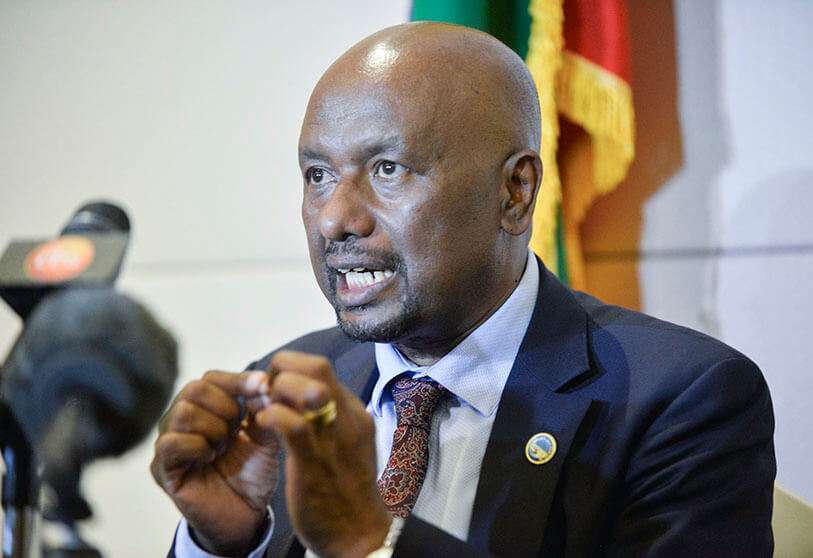Ethiopia is reported to have started second filling of Ethiopian Renaissance Dam

The second filling of the Grand Ethiopian Renaissance Dam (GERD) was planned for the summer, in July and August, coinciding with the rainy season. This second filling of the dam, according to Ethiopia, will take place with or without an agreement between the disputing countries: Egypt and Sudan. A series of negotiations stalled in April and tensions have been rising ever since.
According to a senior Sudanese official, Ethiopia began the second filling in early May, an allegation to which the Ethiopian authorities did not immediately respond. The move alarmed downstream countries Sudan and Egypt, which were seeking a legally binding agreement on the dam's operation and have stepped up their efforts to secure one ahead of the second phase of filling.
Ethiopia denies reports that a second filling began in early May. Hanly Raslan, an Africa expert at Egypt's Al-Ahram Centre for Political and Strategic Studies, says the reports may have been inspired by the storage of a "negligible" amount of water behind the dam due to heavier than usual rainfall.

Sudan warned in April that it could take legal action against Ethiopia if it goes ahead with plans to fill a mega-dam on the Blue Nile without a deal with Khartoum and Cairo. The GERD has been a source of tension in the Nile River basin since construction began in 2011, negotiations have been suspended and resumed multiple times since then.
Ethiopian Water Minister Seleshi Bekele told Reuters news agency that Addis Ababa did not believe negotiations between the three countries were finished or had failed and added that the appropriate next step would be for the heads of states to meet under the auspices of the AU.
When construction of the dam began, Egypt, along with other Arab countries, was in the throes of the Arab Spring. From the start of its construction they tried to stop it, tensions even rose to the threat of military conflict. Arid Egypt relies on the Nile for 90% of its fresh water and sees the dam as a potential threat. Sudan, Egypt's strategic political ally, is concerned about the operation of its own Nile dams and hydropower stations, although it could benefit from importing power generated by the Grand Dam.

In 2019, Ethiopian Prime Minister Abiy Ahmed said that "no force can stop Ethiopia from building the dam". Dam construction started on 2 April 2011 at an estimated cost of $4.8 billion. Located on the Blue Nile, with a capacity of 74 billion cubic metres and a size of 1,700 square kilometres, it is expected to generate up to 6,000 megawatts of power.
The country is currently only capable of generating 4,000 megawatts, so this project represents a significant increase in its energy capacity. It will allow not only a higher percentage of the population to have access to electricity, but also an energy surplus that could be exported to other countries. For this reason, it is not only a great development opportunity for Ethiopia, but can also be a cheap source of energy for its neighbouring countries, e.g. Sudan.
Ethiopia aims to fill the reservoir in three years, while Egypt wants the duration to be seven years. Since May 2011, Cairo has expressed concern about how the dam could reduce the country's annual quotas of 55.5 billion cubic metres of Nile water. According to the Central Agency for Public Mobilisation and Statistics (CAPMAS) in 2014, Egypt's average per capita water intake is expected to decrease from 663 cubic metres per year to 582 cubic metres by 2025. However, Addis Ababa said the dam is necessary for its development and will not harm downstream countries.

In an interview with DW News, Ethiopian journalist Tsedale Lemma says that during the coming rainy months, the dam is expected to hold back 13.5 billion cubic metres of water. Its capacity to generate energy will also be tested. Together with the first filling, this would amount to 18.4 billion cubic metres of water, which is almost 25 per cent of its estimated total capacity.
The fact that the filling takes place during the rainy season is also beneficial for Sudan, as it avoids the severe flooding that often occurs during that time of the year. This project is very important for Ethiopia as 65% of its population has no access to electricity, making it an important development project. In addition, Tsedale Lemma stresses that 80% of the Nile's water comes from Ethiopia, and from the Ethiopian point of view, it is their natural right to be able to exploit this resource.

Until now, Egypt controlled the majority of the Nile's waters. According to its treaty with the former British Empire in 1929, the African country had veto power over any construction or project on the river. Together with Sudan, it therefore maintains that the colonial agreement should be respected. Ethiopia stresses that they did not sign the agreement and are therefore not bound by it, but refers to the Declaration of Principles on the PGRE signed on 23 March 2015 by Egypt, Ethiopia and Sudan in Khartoum.
The declaration consists of 10 principles: cooperation, development, regional integration and sustainability, no significant harm, fair and appropriate use, cooperation in the first filling and management of the dam, confidence building, information and data flow, security of the dam, sovereignty and unity, and peaceful resolution of conflicts.










